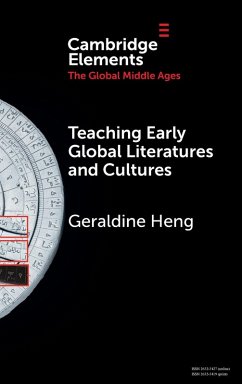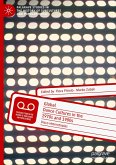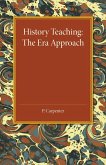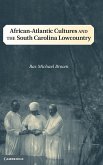Geraldine Heng
Teaching Early Global Literatures and Cultures
Geraldine Heng
Teaching Early Global Literatures and Cultures
- Gebundenes Buch
- Merkliste
- Auf die Merkliste
- Bewerten Bewerten
- Teilen
- Produkt teilen
- Produkterinnerung
- Produkterinnerung
Teaching Early Global Literatures and Cultures is a guide to the terra incognita of the global literature classroom. It should be possible for faculty and graduate instructors to take this Element and begin teaching its sample syllabus right away.
Andere Kunden interessierten sich auch für
![Global Dance Cultures in the 1970s and 1980s Global Dance Cultures in the 1970s and 1980s]() Global Dance Cultures in the 1970s and 1980s113,99 €
Global Dance Cultures in the 1970s and 1980s113,99 €![Global Dance Cultures in the 1970s and 1980s Global Dance Cultures in the 1970s and 1980s]() Global Dance Cultures in the 1970s and 1980s113,99 €
Global Dance Cultures in the 1970s and 1980s113,99 €![Rome, St. Paul & the Early Church. The Influence of Roman law on St. Paul's Teaching & Phraseology and on the Development of the Church Rome, St. Paul & the Early Church. The Influence of Roman law on St. Paul's Teaching & Phraseology and on the Development of the Church]() W. S. MuntzRome, St. Paul & the Early Church. The Influence of Roman law on St. Paul's Teaching & Phraseology and on the Development of the Church31,99 €
W. S. MuntzRome, St. Paul & the Early Church. The Influence of Roman law on St. Paul's Teaching & Phraseology and on the Development of the Church31,99 €![Teaching Central American Literature in a Global Context Teaching Central American Literature in a Global Context]() Gloria Elizabet ChacónTeaching Central American Literature in a Global Context97,99 €
Gloria Elizabet ChacónTeaching Central American Literature in a Global Context97,99 €![History Teaching History Teaching]() P. CarpenterHistory Teaching23,99 €
P. CarpenterHistory Teaching23,99 €![The Teaching of History The Teaching of History]() Eugene Lewis HasluckThe Teaching of History33,99 €
Eugene Lewis HasluckThe Teaching of History33,99 €![African-Atlantic Cultures and the South Carolina Lowcountry African-Atlantic Cultures and the South Carolina Lowcountry]() Ras Michael BrownAfrican-Atlantic Cultures and the South Carolina Lowcountry109,99 €
Ras Michael BrownAfrican-Atlantic Cultures and the South Carolina Lowcountry109,99 €-
-
-
Teaching Early Global Literatures and Cultures is a guide to the terra incognita of the global literature classroom. It should be possible for faculty and graduate instructors to take this Element and begin teaching its sample syllabus right away.
Produktdetails
- Produktdetails
- Verlag: Cambridge University Press
- Seitenzahl: 114
- Erscheinungstermin: 6. Mai 2025
- Englisch
- Abmessung: 235mm x 157mm x 11mm
- Gewicht: 328g
- ISBN-13: 9781009633048
- ISBN-10: 100963304X
- Artikelnr.: 73310563
- Herstellerkennzeichnung
- Libri GmbH
- Europaallee 1
- 36244 Bad Hersfeld
- gpsr@libri.de
- Verlag: Cambridge University Press
- Seitenzahl: 114
- Erscheinungstermin: 6. Mai 2025
- Englisch
- Abmessung: 235mm x 157mm x 11mm
- Gewicht: 328g
- ISBN-13: 9781009633048
- ISBN-10: 100963304X
- Artikelnr.: 73310563
- Herstellerkennzeichnung
- Libri GmbH
- Europaallee 1
- 36244 Bad Hersfeld
- gpsr@libri.de
1. Introduction: An Experiment in Learning - and Teaching - Early Global
Literatures and Cultures; 2. Why Teach Early Global Literatures and
Cultures?; 3. Organizing a Course, and a Scaffold of Questions in Search of
Answers; 4. What Should We Teach? Two Dozen Texts from Which to Extract a
Possible Syllabus; 5. What Interconnects the Early World of AfroEurasia?
What Does that Early World Look like? Teaching The Vinland Sagas, Sundiata:
An Epic of Old Mali, and Ibn Fadlan's Mission to the Volga as Global Texts;
6. Encountering the Other, or Slaves, Race, Religion, Gender, and Sexuality
in a World of Differences: Teaching 'The Slave of MS. H.6,' selected
documents from India Traders of the Middle Ages, Amitav Ghosh's In an
Antique Land: History in the Guise of a Traveler's Tale, and Kamaluddin
Abdul-Razzaq Samarqandi's Mission to Calicut and Vijayanagar; 7. Oceans of
Stories, and Island Worlds: Teaching Buzurg ibn Shahriyar's Book of the
Wonders of India, and Abu Zayd Al-Sirafi's Accounts of India and China,
with the Malay Annals; 8. The Globalism of Pax Mongolica: Teaching the
Secret History of the Mongols and Marco Polo-Rustichello of Pisa's
Description of the World; 9. The Role/s of Students in the Early Global
Literature Classroom: Taking Ownership of the Course, Research, and Team
Projects.
Literatures and Cultures; 2. Why Teach Early Global Literatures and
Cultures?; 3. Organizing a Course, and a Scaffold of Questions in Search of
Answers; 4. What Should We Teach? Two Dozen Texts from Which to Extract a
Possible Syllabus; 5. What Interconnects the Early World of AfroEurasia?
What Does that Early World Look like? Teaching The Vinland Sagas, Sundiata:
An Epic of Old Mali, and Ibn Fadlan's Mission to the Volga as Global Texts;
6. Encountering the Other, or Slaves, Race, Religion, Gender, and Sexuality
in a World of Differences: Teaching 'The Slave of MS. H.6,' selected
documents from India Traders of the Middle Ages, Amitav Ghosh's In an
Antique Land: History in the Guise of a Traveler's Tale, and Kamaluddin
Abdul-Razzaq Samarqandi's Mission to Calicut and Vijayanagar; 7. Oceans of
Stories, and Island Worlds: Teaching Buzurg ibn Shahriyar's Book of the
Wonders of India, and Abu Zayd Al-Sirafi's Accounts of India and China,
with the Malay Annals; 8. The Globalism of Pax Mongolica: Teaching the
Secret History of the Mongols and Marco Polo-Rustichello of Pisa's
Description of the World; 9. The Role/s of Students in the Early Global
Literature Classroom: Taking Ownership of the Course, Research, and Team
Projects.
1. Introduction: An Experiment in Learning - and Teaching - Early Global
Literatures and Cultures; 2. Why Teach Early Global Literatures and
Cultures?; 3. Organizing a Course, and a Scaffold of Questions in Search of
Answers; 4. What Should We Teach? Two Dozen Texts from Which to Extract a
Possible Syllabus; 5. What Interconnects the Early World of AfroEurasia?
What Does that Early World Look like? Teaching The Vinland Sagas, Sundiata:
An Epic of Old Mali, and Ibn Fadlan's Mission to the Volga as Global Texts;
6. Encountering the Other, or Slaves, Race, Religion, Gender, and Sexuality
in a World of Differences: Teaching 'The Slave of MS. H.6,' selected
documents from India Traders of the Middle Ages, Amitav Ghosh's In an
Antique Land: History in the Guise of a Traveler's Tale, and Kamaluddin
Abdul-Razzaq Samarqandi's Mission to Calicut and Vijayanagar; 7. Oceans of
Stories, and Island Worlds: Teaching Buzurg ibn Shahriyar's Book of the
Wonders of India, and Abu Zayd Al-Sirafi's Accounts of India and China,
with the Malay Annals; 8. The Globalism of Pax Mongolica: Teaching the
Secret History of the Mongols and Marco Polo-Rustichello of Pisa's
Description of the World; 9. The Role/s of Students in the Early Global
Literature Classroom: Taking Ownership of the Course, Research, and Team
Projects.
Literatures and Cultures; 2. Why Teach Early Global Literatures and
Cultures?; 3. Organizing a Course, and a Scaffold of Questions in Search of
Answers; 4. What Should We Teach? Two Dozen Texts from Which to Extract a
Possible Syllabus; 5. What Interconnects the Early World of AfroEurasia?
What Does that Early World Look like? Teaching The Vinland Sagas, Sundiata:
An Epic of Old Mali, and Ibn Fadlan's Mission to the Volga as Global Texts;
6. Encountering the Other, or Slaves, Race, Religion, Gender, and Sexuality
in a World of Differences: Teaching 'The Slave of MS. H.6,' selected
documents from India Traders of the Middle Ages, Amitav Ghosh's In an
Antique Land: History in the Guise of a Traveler's Tale, and Kamaluddin
Abdul-Razzaq Samarqandi's Mission to Calicut and Vijayanagar; 7. Oceans of
Stories, and Island Worlds: Teaching Buzurg ibn Shahriyar's Book of the
Wonders of India, and Abu Zayd Al-Sirafi's Accounts of India and China,
with the Malay Annals; 8. The Globalism of Pax Mongolica: Teaching the
Secret History of the Mongols and Marco Polo-Rustichello of Pisa's
Description of the World; 9. The Role/s of Students in the Early Global
Literature Classroom: Taking Ownership of the Course, Research, and Team
Projects.








